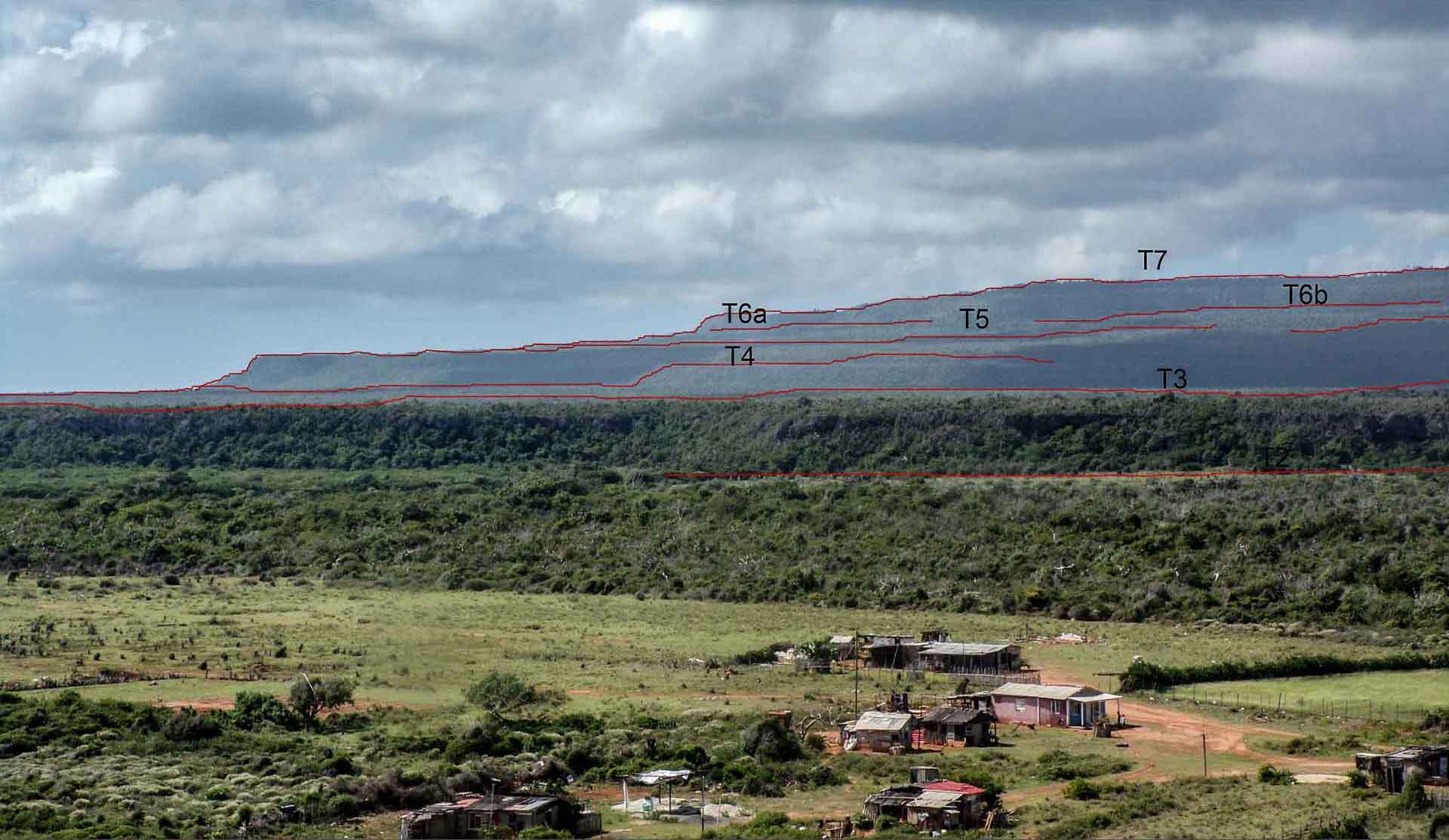Quaternary interglacial coral and marine uplifted terraces of Maisí
CUBA

General view of coral and marine uplifted terraces at south of Maisí municipality, eastern of Guantánamo province, Cuba.
Geological Period
Quaternary
Main geological interest
Geomorphology and active geological processes
Stratigraphy and sedimentology
Location
Punta de Maisí, Guantánamo province, Cuba.
20° 08′ 10” N, 074° 13′ 59” W
General view of coral and marine uplifted terraces at south of Maisí municipality, eastern of Guantánamo province, Cuba.
ONE OF THE BEST PRESERVED MARINE AND CORAL UPLIFTED TERRACES SEQUENCES IN THE WORLD BY INTERACTION OF GLOBAL SEA LEVEL AND TECTONICS.
The marine and coral uplifted terraces of Maisí are a very important source of information to reveal the tectonics of the Greater Antilles within the Caribbean domain during the Quaternary Period. As a result of multiple investigations, marine terraces are known in Haiti, in Lesser Antilles and other parts of the world is known. The marine terraces in Cuba can be correlated with global sea-level changes in the Quaternary. In addition to being in an area regularly impacted by hurricanes, this area is important for studying wave energy during these meteorological events.
- Geological description
The marine and coral terraces are made up of coral and shelly limestone with abundant fossils. They are underlain by the Jaimanitas Formation of Late Pleistocene age (MIS 5e, 122 ± 6 ka) (Toscano et al., 1999) and older, underlying Pleistocene strata. About 28 terrace levels are observed, with an elevation up to 560 ± 10 m. Most of the terraces are very well preserved where fossil tidal notches, caverns and other karst features are present. These represent the record of approximately 2 Ma of sea level fluctuations. The area is tectonically linked to the Oriente transform fault zone in eastern Cuba, which is the boundary between the North American and Caribbean plates, where block uplifts of 0.33 ± 0.01 mm/yr are recorded (Peñalver et al., 2021). Geomorphologically, the area is a large ring of about 75 km long covering the eastern coastal zone of Cuba as a staircase being narrow at north and south, and wider in the east corner. Steps are cut by rivers forming gorges with large transversal outcrops. Due to the active tectonics, predominantly tilting and folding, in some places the same step has different altitude at both sides of the gorge. The lower terrace has blocks overturned from the sea by hurricanes and landslide features like crowns are observed.
- Scientific research and tradition
These terraces were described as early as 1898 (Hersey, 1898), and investigations have continued to the present day (Muhs et al., 2017). Recent radioisotopic dating was carried out to investigate relationships between erosion of terraces and tectonics and climate.
- Reference
Del Busto, R. (1975) ‘Las terrazas marinas de Maisí’, in Ciencia. (Serie 7 Geografía, 10), pp. 1–12. Available at: http://repositorio.geotech.cu/jspui/handle/1234/2185 (Accessed: 3 August 2022).
Del Corral, J.I. (1945) ‘Terrazas pleistocénicas cubanas’, Revista de la Sociedad Cubana de Ingenieros, 40(1), pp. 5–44.
Hershey, O.H. (1898) ‘Raised Shore-lines on Cape Maysi, Cuba’, Science, 8(189), pp. 179–180. Available at: https://doi.org/10.1126/science.8.189.179.
Muhs, D.R. et al. (2017) ‘Late Quaternary uplift along the North America-Caribbean plate boundary: Evidence from the sea level record of Guantanamo Bay, Cuba’, Quaternary Science Reviews, 178, pp. 54–76. Available at: https://doi.org/10.1016/j.quascirev.2017.10.024.
Peñalver, L. et al. (2021) ‘The Cuban staircase sequences of coral reef and marine terraces: A forgotten masterpiece of the Caribbean geodynamical puzzle’, Marine Geology, 440, p. 106575. Available at: https://doi.org/10.1016/j.margeo.2021.106575.
Toscano, M.A., Rodriguez, E. and Lundberg, J. (1999) ‘Geological investigation of the late Pleistocene Jaimanitas Formation: science and society in Castro´s Cuba’, in Proceedings of the 9th Symposium on the Geology of the Bahamas and Other Carbonate Regions , San Salvador, Bahamas. Bahamian Field Station.
- Author(s)
Leandro L. Peñalver Hernández
Institute de Geology y Paleontology/Geological Survey of Cuba
Kevin Pedoja
University of Caen Normandy, France
Arelis Nuñez Labañino
Institute de Geology y Paleontology/Geological Survey of Cuba.
Christine Authemayou
Université de Bretagne Occidentale Plouzané, France
Pedro Dunán Ávila
Université de Bretagne Occidentale Plouzané, France
Pedro Benítez Frómeta
Institute de Geology y Paleontology/Geological Survey of Cuba
Enrique A. Castellanos Abella
Ministry of Energy and Mines, Cuba

